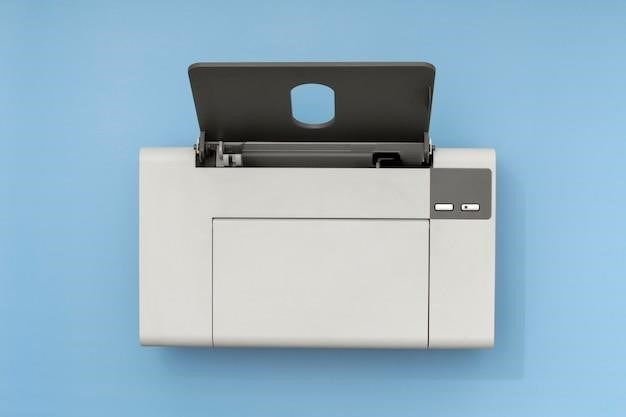Brother XL-2600i⁚ A Comprehensive Guide
This guide provides a complete overview of the Brother XL-2600i sewing machine, covering its features, setup, basic and advanced techniques, troubleshooting, and maintenance.

Introduction
The Brother XL-2600i is a versatile and reliable sewing machine designed for both beginners and experienced sewists. This comprehensive guide aims to provide you with all the information you need to get the most out of your Brother XL-2600i. Whether you’re a seasoned seamstress or just starting your sewing journey, this manual will guide you through every step, from unpacking and setting up your machine to mastering advanced sewing techniques. We’ll cover everything from basic sewing techniques like straight stitching and zigzag stitching to more advanced skills like free-arm sewing, reverse sewing, and embroidery. We’ll also address common problems and solutions, provide tips on cleaning and lubrication, and guide you through replacing parts. This manual is your ultimate resource for unlocking the full potential of your Brother XL-2600i.
Key Features and Benefits
The Brother XL-2600i is packed with features that make sewing a breeze. It boasts 25 built-in stitches, including basic stitches like straight stitch and zigzag stitch, as well as decorative stitches and utility stitches. This variety allows you to tackle a wide range of sewing projects, from simple repairs to intricate garments. The XL-2600i also features a convenient free arm for sewing sleeves and cuffs, making it easy to maneuver fabric around tight curves. The automatic needle threader eliminates the frustration of threading the needle by hand, and the adjustable stitch length and width provide precise control over your stitches. Other notable features include a built-in buttonhole maker, a reverse stitch function for securing seams, and a drop-in bobbin system for easy bobbin replacement. The XL-2600i’s sturdy construction and user-friendly design make it a reliable and enjoyable sewing companion, whether you’re a seasoned sewist or just starting out.
Getting Started
Before you start sewing, it’s essential to familiarize yourself with the Brother XL-2600i and its components. Begin by unpacking the machine carefully, ensuring that all parts are present and in good condition. Refer to the instruction manual for a detailed breakdown of the machine’s parts and their functions. Connect the power cord and plug it into a suitable electrical outlet. The next step is to thread the machine, a process that is clearly illustrated in the manual. Selecting the right needle and thread for your project is crucial for achieving smooth and professional-looking results. The manual provides guidance on choosing the appropriate needle and thread based on the fabric type and sewing task. Once you’ve successfully threaded the machine and chosen the right needle and thread, you’re ready to start sewing.
Unpacking and Setting Up
Begin by carefully unpacking the Brother XL-2600i sewing machine from its box. Ensure that all components are present, including the machine itself, the foot pedal, the power cord, and any accessories that came with it. Inspect the machine for any signs of damage during shipping. Find a stable and flat surface to set up your machine; Place the machine on the surface and make sure it is level. Connect the foot pedal to the machine, and then plug the power cord into a suitable electrical outlet. Before using the machine for the first time, it is recommended to read the instruction manual thoroughly. The manual provides detailed instructions on how to assemble and set up the machine, including how to thread the needle, wind the bobbin, and adjust the tension. Once you have familiarized yourself with the machine and its features, you are ready to begin sewing.
Threading the Machine
Threading the Brother XL-2600i sewing machine is a straightforward process. Begin by raising the presser foot and winding the bobbin with the desired thread. Then, insert the bobbin into the bobbin case and secure it in place. Next, thread the needle from the spool pin through the thread guide, then through the tension discs. Continue threading the needle by passing it through the take-up lever and then through the needle from front to back. Finally, pull the thread through the needle eye and gently pull the thread to ensure it is properly threaded. It is crucial to follow the threading diagram provided in the instruction manual to ensure correct threading. If the thread is not threaded correctly, the machine may not sew properly, resulting in skipped stitches or other problems. Always refer to the manual for specific instructions and illustrations for your model.
Choosing the Right Needle and Thread
Selecting the appropriate needle and thread for your sewing project is essential for achieving optimal results with your Brother XL-2600i. The type of fabric you are working with will determine the needle size and thread weight. For delicate fabrics like silk or chiffon, a fine needle (size 70/10 or 80/12) and a lightweight thread are recommended. For heavier fabrics, such as denim or canvas, you will need a heavier needle (size 90/14 or 100/16) and a thicker thread. Consider using a ballpoint needle for knit fabrics to prevent skipped stitches and damage to the fabric. Always ensure the needle is sharp and free from burrs, and replace it regularly for optimal performance. Matching the thread color to the fabric is crucial for creating a seamless and professional look.
Basic Sewing Techniques
The Brother XL-2600i offers a range of stitch options that are ideal for mastering essential sewing techniques. Mastering these techniques will lay the foundation for more advanced projects. Straight stitching is the most fundamental technique, used for seams, hems, and straight lines. Adjust the stitch length to suit the fabric and desired appearance. Zigzag stitching is versatile for securing edges, creating decorative details, and finishing seams. Experiment with different stitch widths and lengths to achieve varying effects. Buttonholes are a common sewing task that can be achieved with the XL-2600i’s automatic buttonhole function. Select the appropriate buttonhole size and follow the machine’s instructions to create professional-looking buttonholes. Practice these basic techniques to gain confidence and expand your sewing repertoire.
Straight Stitching
Straight stitching is the most fundamental technique in sewing, forming the basis for seams, hems, and other straight lines. The Brother XL-2600i simplifies this technique with its adjustable stitch length, allowing you to control the density and appearance of your stitches. For stronger seams, use a shorter stitch length, while longer stitches are ideal for looser hems or decorative purposes. To achieve a perfect straight stitch, ensure the fabric is evenly fed under the presser foot, using the feed dog mechanism to guide the fabric smoothly. Consistent speed and gentle pressure will result in a clean, professional-looking straight stitch.
Zigzag Stitching
Zigzag stitching is a versatile technique that adds a decorative touch and enhances the durability of your sewing projects. The Brother XL-2600i offers adjustable zigzag stitch width and length, allowing you to customize the appearance of your stitches. A wider zigzag stitch is useful for finishing edges and preventing fraying, while a narrower stitch can create a more delicate, decorative effect. Zigzag stitching is also commonly used for creating buttonholes, securing seams, and adding decorative accents to fabric. Mastering zigzag stitching expands your sewing capabilities, opening up a world of creative possibilities.
Buttonholes
The Brother XL-2600i makes creating professional-looking buttonholes a breeze. Its semi-automatic buttonhole function guides you through the process, ensuring consistent and precise results. You can adjust the buttonhole length to accommodate different button sizes and styles. Before stitching the buttonhole, mark the desired length on your fabric using a tailor’s chalk or a marking pen. The machine then automatically stitches the buttonhole, creating a clean and even opening. To reinforce the edges and prevent fraying, the machine stitches a short bar tack at the beginning and end of the buttonhole. With the XL-2600i’s buttonhole feature, you can confidently create garments that are both stylish and functional.
Advanced Sewing Techniques
The Brother XL-2600i equips you with a variety of advanced sewing techniques to elevate your projects. Mastering these techniques can unlock a world of creative possibilities and enhance your sewing skills. The free-arm sewing feature allows you to sew intricate details on sleeves, cuffs, or pant legs with ease. The machine’s reverse sewing function helps you reinforce seams and prevent unraveling. This feature is especially useful for securing the beginning and end of seams, ensuring a professional finish. While the XL-2600i might not offer built-in embroidery features, its versatility allows for experimenting with hand embroidery, adding a personalized touch to your creations.
Free-Arm Sewing
The Brother XL-2600i offers a convenient free-arm sewing feature, allowing you to sew intricate details on cylindrical or tubular fabric without the bulk of the sewing machine bed getting in the way. This feature is particularly useful for sewing sleeves, cuffs, pant legs, and other garment areas that require precise stitching around curves. By detaching the sewing bed extension, you can access the free arm, which resembles a smaller sewing machine with a single needle and feed dog. This allows for enhanced maneuverability, making it easier to sew tight curves and corners with precision. This technique is ideal for projects that require delicate stitching, such as sewing buttonholes, attaching lace, or creating decorative seams on curved areas.
Reverse Sewing
Reverse sewing, also known as back stitching, is a crucial technique for securing seams and preventing unraveling. The Brother XL-2600i incorporates a convenient reverse sewing function, allowing you to stitch backward to reinforce the start and end points of your seams. To engage reverse sewing, simply press the reverse stitch button, which is typically located near the needle position control. This will cause the needle to move backward, creating a series of stitches that lock the thread in place. By using reverse stitching at the beginning and end of your seams, you can prevent the thread from pulling out and ensure that your seams are securely fastened, providing a more durable and professional finish to your projects. This feature is particularly helpful when sewing garments, as it helps to prevent seams from coming undone under stress or wear.
Embroidery
While the Brother XL-2600i is a versatile sewing machine, it is not specifically designed for embroidery. It features a limited selection of decorative stitches that can be used for basic embroidery, but it lacks the advanced features and capabilities found in dedicated embroidery machines. If you are looking to explore the world of embroidery, you may want to consider investing in a machine specifically designed for this purpose. These machines offer a wider range of embroidery stitches, patterns, and designs, allowing you to create intricate and elaborate designs on fabric. They often come with a digital display, allowing you to preview and edit designs before stitching. Additionally, embroidery machines typically have a larger work area, enabling you to embroider larger designs and projects.
Troubleshooting and Maintenance
Regular maintenance is essential to ensure your Brother XL-2600i sewing machine operates smoothly and delivers optimal performance. To keep your machine running well, it’s important to address common problems promptly. If you encounter issues such as skipped stitches, uneven tension, or needle breakage, consult the troubleshooting section in your user manual for potential solutions. Cleaning your machine regularly is crucial for preventing dust and lint build-up, which can impede its functionality. Use a soft brush to remove dust and debris from the bobbin case, feed dog, and other internal components. Lubrication is also essential for ensuring smooth operation. Apply a few drops of sewing machine oil to the moving parts, such as the needle bar, bobbin winder, and feed dog, to reduce friction and prevent wear. Finally, replace worn-out parts like needles and bobbins as needed to maintain the machine’s performance and safety.
Common Problems and Solutions
The Brother XL-2600i is a reliable machine, but like any mechanical device, it can encounter occasional issues. Some common problems include skipped stitches, uneven tension, and needle breakage. Skipped stitches can be caused by a dull needle, improper threading, or incorrect needle size. To resolve this, replace the needle with a new one of the appropriate size, double-check your threading, and ensure the needle is properly inserted. Uneven tension can occur if the thread is too loose or too tight. Adjust the tension dials on both the upper and lower threads to achieve a balanced tension. If the needle keeps breaking, inspect the needle for burrs or bends. Replace it with a new one, and ensure it’s inserted properly. If these steps don’t resolve the problem, consult your user manual for more detailed troubleshooting guides or contact a qualified technician.
Cleaning and Lubrication
Regular cleaning and lubrication are essential for maintaining the smooth operation of your Brother XL-2600i sewing machine. To clean the machine, unplug it from the power source and gently remove any loose threads or fabric scraps. Use a soft brush or a vacuum cleaner with a brush attachment to remove dust and debris from the bobbin case, needle plate, and feed dog area. Avoid using any harsh chemicals or solvents. To lubricate the machine, apply a few drops of sewing machine oil to the moving parts, such as the needle bar, bobbin race, and feed dog mechanism. Avoid over-lubrication, as it can attract dust and dirt. Follow the instructions in your user manual for specific lubrication points.
Replacing Parts
Over time, certain parts of your Brother XL-2600i sewing machine may require replacement. This includes items like needles, bobbins, presser feet, and even the sewing machine needle plate. Before replacing any parts, consult your user manual for detailed instructions and diagrams. Ensure you use genuine Brother parts to maintain the quality and performance of your machine. When replacing the needle, always choose the correct size and type for your fabric and sewing project. A worn or damaged needle can lead to skipped stitches, thread breakage, or even fabric damage. Regularly inspect your bobbin case for wear and tear, and replace it if necessary. Remember to clean the bobbin case thoroughly before inserting a new bobbin.


